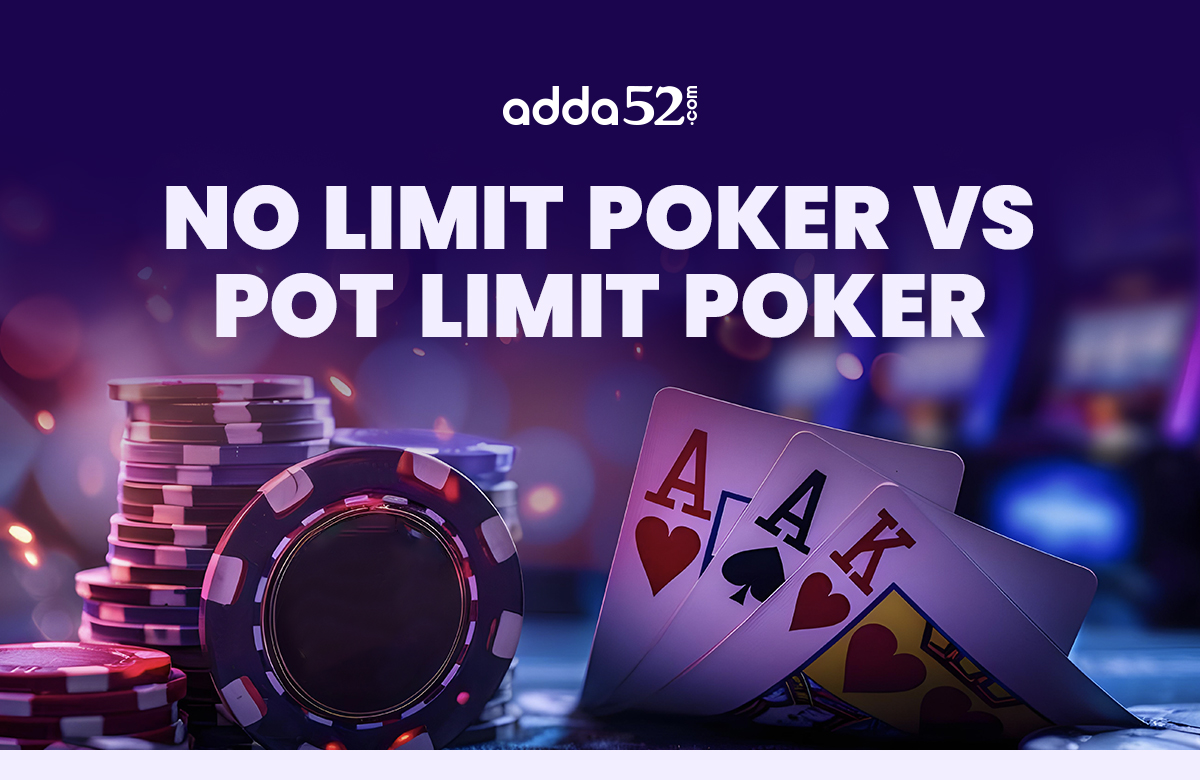No Limit Poker Vs Pot Limit Poker

Introduction
Poker offers a range of variations, each with its own set of rules and strategies. Although No-Limit and Pot-Limit Poker are the most popular versions, they offer unique playing experiences with similar fundamentals due to differences in their betting structures.
In this article, we will explore the similarities and differences between No-Limit and Pot-Limit Poker in depth.
What is No Limit Poker?
Without limitations, players in No Limit Poker can bet or raise and put their entire stack on the line. This version of poker has become a popular feature of Texas Hold'em and is enjoyed by those who play cash games and tournaments.
What is a Pot Limit Poker?
Pot-limit poker involves players betting a maximum amount equal to the size of the pot while playing. To determine this limit, one adds up all bets made in current rounds and necessary calls for outstanding bets. The widespread appeal of such gameplay is evident in games like Pot-Limit Omaha (PLO).
No Limit Poker Versus Pot Limit Poker
Here are the differences between these two popular variations of Poker.
Betting Limits
No Limit Poker: Players can bet or raise any amount they desire without a maximum limit. It is possible for players to place their entire chip stack as a single wager.
Pot Limit Poker: A player's maximum bet is determined by the present pot size. When there are ₹100 in the pot, a player can place or increase bets up to₹100.
Pace of the Game
No Limit Poker: If there is no limit to betting, it can cause major changes in chip stacks and game momentum. The bigger bets can result in faster eliminations during a tournament match. However, not having a cap on betting lets you take greater risks which may end up being lucrative with impressive rewards.
Pot Limit Poker: The capped betting structure typically results in fewer sudden shifts in chip stacks. This can result in a more methodical pace and often longer-lasting hands and tournaments.
Popularity
No Limit Poker: This format is especially popular in Texas Hold'em, the most widely played poker variant in the world. It is the standard for many major tournaments, including the World Series of Poker (WSOP) Main Event.
Pot Limit Poker: Commonly associated with Pot Limit Omaha (PLO), a popular variant that thrives on the pot limit structure. PLO is known for its action-packed nature, benefiting from the balance between controlled betting and the potential for massive pots.
Player Psychology and Behavior
No Limit Poker: Players often face more intense psychological pressure due to the possibility of all-in bets at any moment. This can lead to more frequent bluffing and aggressive behaviour as players attempt to use the threat of large bets to intimidate opponents.
Pot Limit Poker: The psychological aspects are slightly different because players cannot threaten with unlimited bets. Bluffing still occurs but may be less frequent and requires more precise timing and calculation, as opponents know they would not face the same level of extreme pressure.
Hand Value and Play Style
No Limit Poker: Hands that can potentially make strong top pairs or sets are particularly valuable, as players can win big pots with these hands. The potential to go all-in means that even medium-strength hands can sometimes be played aggressively to extract maximum value or force opponents to fold.
Pot Limit Poker: Drawing hands and hands with strong post-flop potential (like suited connectors in PLO) gain more importance. The ability to only bet the size of the pot makes it less likely to push opponents off hands pre-flop, leading to more multi-way pots and post-flop play.
Tournament Play and Structure
No Limit Poker: Tournaments in this format often have faster structures due to the potential for quick eliminations. The ability to make large bets or go all-in can significantly change the situation on the table, especially in later stages where players are more willing to risk their stacks.
Pot Limit Poker: Tournaments tend to progress at a steadier pace. The capped bets mean players must rely on more consistent play over time rather than sudden shifts in stack sizes. This can result in longer-lasting tournaments and a different approach to chip accumulation and survival.
Bankroll Management
No Limit Poker: The potential for large swings in chip stacks requires careful bankroll management. Players need to be prepared for high variance and the possibility of significant losses in a short period. This format is often considered more high-stakes due to the potential for large, single-hand losses.
Pot Limit Poker: The regulated betting system often leads to smoother fluctuations in chip stacks, minimizing the possibility of losing one's entire bankroll on a single hand. This enhances overall stability when managing funds. Players can employ more measured and strategic bankroll management.
Impact of Position
No Limit Poker: The role of position is paramount since players occupying later positions can effectively exert immense pressure through larger bets or raises. Having a favourable position provides greater authority over the pot size and enables better decisions to be made based on opponents' actions.
Pot Limit Poker: While the position is still important, the impact is slightly mitigated by the pot limit rule. Players must carefully calculate their bets relative to the pot size, which reduces the ability to apply overwhelming pressure purely based on position. However, being in a later position still offers strategic advantages in controlling the pot and reacting to opponents' actions.
Frequently Asked Questions
Should I play limit or no-limit Poker?
Your risk tendencies and proficiency determine the choice between limit and no-limit poker. In limit poker, the set betting limits offer a steady gaming experience that is perfect for novices looking for predictability. In no-limit poker, you can make unrestricted bets, which can lead to situations with high risks and intensified volatility. Therefore, players who love strategic thinking will find it more appealing.
What is a no-limit game in Poker?
In poker, a no-limit game format means that there are zero restrictions on the maximum bet amount for players at any given time. During gameplay, individuals have the freedom to utilize all of their chips and make singular bets or raises without limitations.
What is the difference between PLO and NLH Poker?
PLO and NLH differ primarily in terms of hand composition and betting structure. Players are dealt four hole cards in PLO but must use only two with three community cards. Players receive two hole cards in NLH and can utilize any combination from the available pool. Unlike NLH, which allows maximum freedom to combine card sets, Pot Limit Omaha adopted a pot limit system that restricts bets within the size of the current pot.
What is the pot rule in Poker?
The betting restrictions in pot limit games are known as the pot rule in Poker. In Pot Limit Poker, players can only place bets up to the current amount of chips within the pot. To determine this value, you need to add up all contributions made by each player thus far and include any pending calls that have not yet been matched. Players can bet or raise any amount up to this calculated pot size.
Conclusion
No Limit offers a thrilling atmosphere for high-stakes betting, while Pot Limit presents an opportunity for more strategic and well-calculated gameplay. Being mindful of these distinctions lets you personalize your tactics for achievement and elevate the level of pleasure derived from the game.
